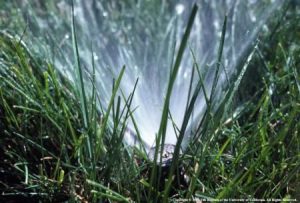The drought of 2011 through 2016 brought attention to water as a truly limited resource, creating new ways of watering and ending many lawns. Within those changed landscapes were established plants and trees that add value to our properties, shade our homes, lower utility bills and create a better environment. If weaned from their accustomed water supply precipitously, these trees and shrubs could become drought-stressed. Trees starved for water easily become prey for disease or invading insects like borers.
How do we water and maintain our trees? By building a watering system that will appropriately provide moisture. If you are designing a drip irrigation system to replace an earlier sprinkler system, here are seven guidelines:
- Determine the water needs of your plants and design the irrigation system to provide it. New plants need more frequent watering until roots are established. Mature plants can often survive on less-frequent irrigation. Plan your drip system to adequately water a mature plant in the hottest time of the year.
- Roots must have a balance of water and air spaces in the soil. Place emitters so that water reaches the roots. Roots will only grow where there is moisture. If moisture is confined to a small section of the plant’s root system your 60 foot mature tree will have dead feeder roots and be root bound. Think of your tree as if it were in the middle of a wheel. The wheel extends all the way out, and even past, the drip line – the last leaf or twig on the exterior of the canopy. Feeder roots live in the top 12 inches of soil all around the wheel. Water needs to go a foot out from the trunk to the drip line, all the way around. You cannot achieve that with one drip line and one emitter. Know your system and the size of the emitters. A one gallon emitter means that the system must run for one hour for the plant to receive a gallon of water.
- Soil type helps determine the amount of water actually needed. Sandy soil drains quickly (requiring more-frequent watering) and clay soil retains more water (requiring less-frequent irrigation). Remember water coming out of a drip emitter goes slowly but cones down, not spreading across the soil then dispersing downwards.
- Supply water to all the roots but take care not to water the crown of the tree because it can cause crown rot.
- Use mulch to help hold moisture in the soil.
- Check moisture levels in your soil a day or two after watering. Using a trowel, dig down 12 inches about 18 inches from the trunk. If the soil is moist, you are golden. If it is dry, water more.
- Become familiar with your controller so that you can make changes based on time of year, weather, plant material, and soil moisture content. Or invest in a “smart controller” that can make some of those changes based on surrounding conditions.
Plants are valuable and add to the value of our property. Balanced, wise watering will maintain your plants and your garden. We are all stewards of this land and the gifts that are attached to it. Smart watering is correct watering for our future.
Julie Silva is a University of California Cooperative Extension Master Gardener of Tuolumne County who actually gardens in Stanislaus County.
UCCE Master Gardeners of Tuolumne County can answer home gardening questions. Call 209-533-5912 or go to: http://ucanr.edu/survey/survey.cfm?surveynumber=7269 to fill out our easy-to-use problem questionnaire. Check out our website at: http://cecentralsierra.ucanr.edu/Master_Gardeners/ You can also find us on Facebook, or pick up the local Master Gardener book “Sharing the Knowledge: Gardening in the Mother Lode” at Mountain Books or the UCCE Office both in Sonora, CA.


